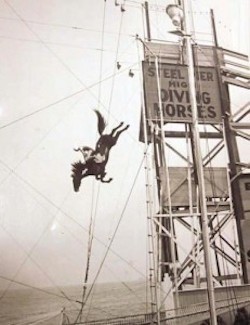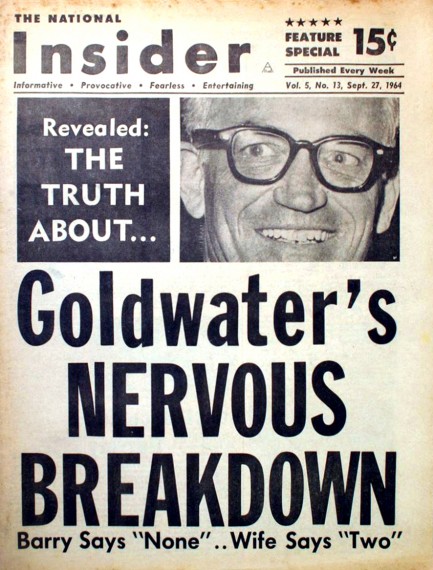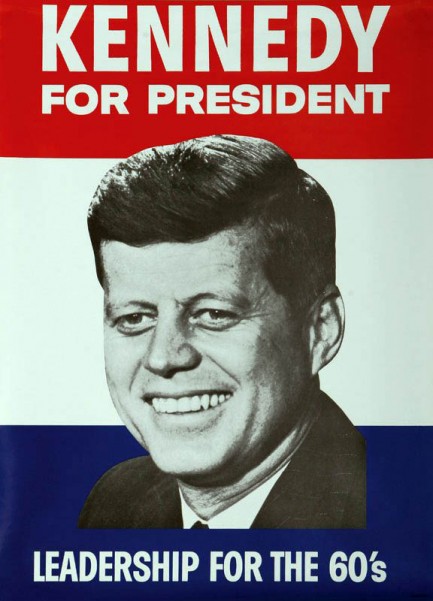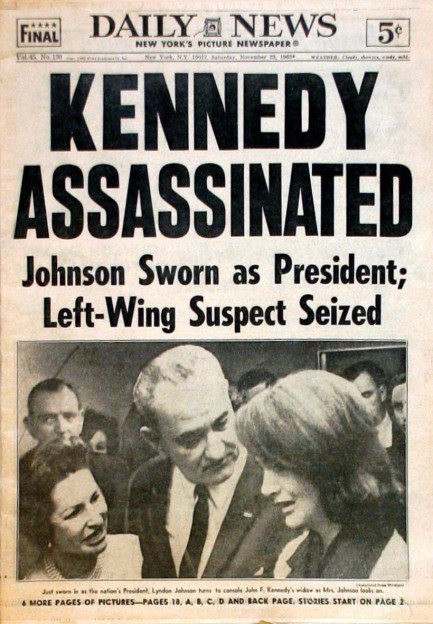| Intl. Notebook | Jul 16 2020 |


| Mondo Bizarro | Aug 25 2018 |


 In the photo at top, sometime during the summer of 1964, a woman at a stunt show in Atlantic City jumps with a horse sporting an LBJ political banner into a tank of water. The leap took place at Steel Pier, and the height, though not discernible in either shot, was about sixty feet.
In the photo at top, sometime during the summer of 1964, a woman at a stunt show in Atlantic City jumps with a horse sporting an LBJ political banner into a tank of water. The leap took place at Steel Pier, and the height, though not discernible in either shot, was about sixty feet.| Intl. Notebook | Sep 27 2014 |


This National Insider from today in 1964 claims that American politician Barry Goldwater had “nervous breakdowns” in 1937 and 1939, but in the midst of his run for president denied they happened. Well, who wouldn’t, right? There’s no new reporting here—Insider is merely echoing the claims of publisher Ralph Ginzburg, who had written of the breakdowns in his magazine Fact, and as evidence had referenced an interview Goldwater’s wife had given Good Housekeeping in May 1964. That’s the inspiration for the line: Barry Says “None” …Wife Says "Two.” Ginzburg was garnering attention for Fact by attacking people from all over the political spectrum, including Bobby Kennedy, and he eventually lost a libel suit regarding his Goldwater claims.
The Goldwater breakdowns are a matter of record today. Ginzburg’s libel suit hinged not on the fact of those incidents, but on embellishments such as his convoluted assessment that Goldwater was “...a man who obviously identifies with a masculine mother rather than an effeminate father.” Goldwater made Ginzburg pay for his ill-considered words, but in the end, both of their careers faltered. Goldwater was crushed in the 1964 presidential election by Lyndon Johnson, and Ginzburg went to jail—not for libel, but for obscenity related to his other magazine Eros. It’s all just another interesting story conjured by another random tabloid cover. And there are still more to come—we have about a hundred full tabloids remaining, everything from Police Gazette to Midnight. We’ll never be able to post them all, but you can bet we’ll try our damndest.
| Intl. Notebook | Nov 22 2013 |


Stories about John F. Kennedy’s assassination have been appearing in the media for several weeks leading up the 50th anniversary of the event, as various outlets try to get ahead of the wave of interest, but we’re purists here, so we’re sharing this poster today, on the actual anniversary of the murder. Let’s get the basics out of the way first. As we’ve mentioned before, a Gallup poll taken days after the killing showed that a majority of Americans believed Oswald was not the only participant. That percentage has gone up since, reaching more than 80%, according to some surveys. That means people who believe Oswald acted with others have always been the majority, and today are the vast majority. That’s something your trusted media outlet always leaves out, doesn’t it? The point is if you think there was a conspiracy, you are the norm, part of an overwhelming norm, rather than some crackpot minority.
It’s an important point because many of the articles published today ask questions like, “Why do people believe in conspiracies?” The problem with that question lies in its framing—it implies that we live in a world that has no or few conspiracies, that it’s silly to believe they exist. That’s very interesting, considering that in the Libor scandal up to 20 major banks conspired to rig interest rates in a $350 trillion derivatives market, that Britain’s spy agency GCHQ conspired to secretly tap into the fiber optic cables that carry the world’s phone calls and internet traffic, that the bank HSBC conspired to launder billions of dollars in South American drug cartel money, that ING conspired to violate sanctions against certain types of business dealings with Cuba and Iran, that News of the World conspired to illegally hack the phones of private citizens, and that Merrill Lynch conspired to deliberately overcharge 95,000 customers $32 million in unwarranted fees. All of these happened in just the last few years.
 To listen to the mainstream media, you’d almost think there weren’t actual criminal proceedings or lawsuits extant in every example we just mentioned. It takes a willful disconnection from reality to deny how prevalent conspiracies are in modern life when hundreds of perpetrators are at this moment sitting as defendants in court because they were caught conspiring. If we want to delve into a few historical examples of conspiracies, then note that the NSA conspired to mislead the U.S. public about the Gulf of Tonkin incident, that American asbestos companies conspired to cover up the truth about the danger of their product, and that in 1962 the U.S. Joint Chiefs of Staff conspired to kill American citizens. That conspiracy took the form of a proposal called Operation Northwoods. In short, American citizens would have been killed in a series of terrorist bomb attacks that would have been blamed on Cuba. Northwoods was approved for implementation by every one of the sitting Joint Chiefs. Really let that sink in. The only reason the American government did not kill American citizens is because John F. Kennedy said no—he wasn’t interested in committing high treason and murder so he could invade Cuba.
To listen to the mainstream media, you’d almost think there weren’t actual criminal proceedings or lawsuits extant in every example we just mentioned. It takes a willful disconnection from reality to deny how prevalent conspiracies are in modern life when hundreds of perpetrators are at this moment sitting as defendants in court because they were caught conspiring. If we want to delve into a few historical examples of conspiracies, then note that the NSA conspired to mislead the U.S. public about the Gulf of Tonkin incident, that American asbestos companies conspired to cover up the truth about the danger of their product, and that in 1962 the U.S. Joint Chiefs of Staff conspired to kill American citizens. That conspiracy took the form of a proposal called Operation Northwoods. In short, American citizens would have been killed in a series of terrorist bomb attacks that would have been blamed on Cuba. Northwoods was approved for implementation by every one of the sitting Joint Chiefs. Really let that sink in. The only reason the American government did not kill American citizens is because John F. Kennedy said no—he wasn’t interested in committing high treason and murder so he could invade Cuba. alone. So the question we should be asking today isn’t why so many people believe in conspiracies, but why the mainstream media are so far removed from the factual realities of human, corporate, and political existence, why they are so resistant to the simple truth that conspiracies are how powerful actors circumvent regulations, laws, and democratic rights. Or more to the point, exactly what planet do mainstream journalists live on? Not this one, seemingly.
alone. So the question we should be asking today isn’t why so many people believe in conspiracies, but why the mainstream media are so far removed from the factual realities of human, corporate, and political existence, why they are so resistant to the simple truth that conspiracies are how powerful actors circumvent regulations, laws, and democratic rights. Or more to the point, exactly what planet do mainstream journalists live on? Not this one, seemingly.



































































